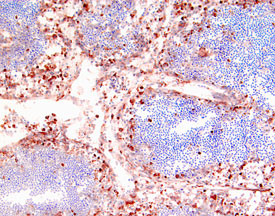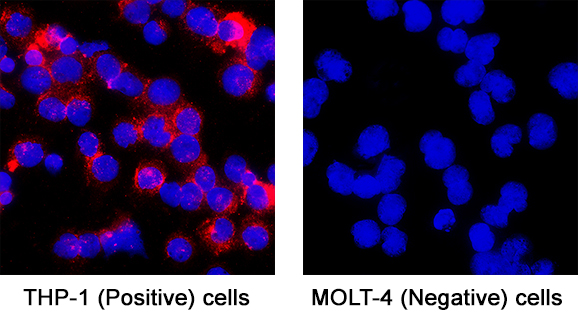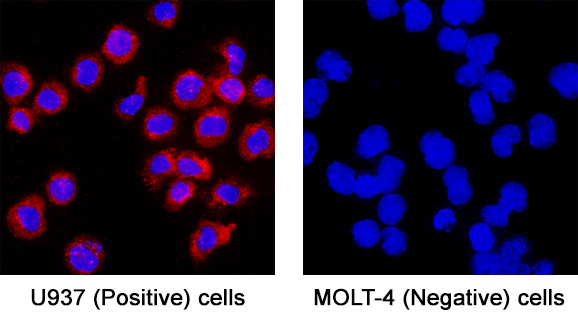Human CD14 Biotinylated Antibody Summary
Thr20-Cys352
Accession # P08571
Applications
Human CD14 Sandwich Immunoassay
Please Note: Optimal dilutions should be determined by each laboratory for each application. General Protocols are available in the Technical Information section on our website.
Scientific Data
 View Larger
View Larger
CD14 in Human Lymph Node. CD14 was detected in immersion fixed paraffin-embedded sections of human lymph node using 10 µg/mL Sheep Anti-Human CD14 Biotinylated Antigen Affinity-purified Polyclonal Antibody (Catalog # BAF383) overnight at 4 °C. Tissue was stained with the Anti-Sheep HRP-AEC Cell & Tissue Staining Kit (red; CTS020) and counterstained with hematoxylin (blue). View our protocol for Chromogenic IHC Staining of Paraffin-embedded Tissue Sections.
 View Larger
View Larger
Detection of CD14 in THP‑1 (Positive) and MOLT‑4 (Negative). CD14 was detected in immersion fixed THP‑1 human acute monocytic leukemia cell line (Positive) and absent in MOLT‑4 human acute lymphoblastic leukemia cell line (Negative) using Sheep Anti-Human CD14 Biotinylated Antigen Affinity-purified Polyclonal Antibody (Catalog # BAF383) at 5 µg/mL for 3 hours at room temperature. Cells were stained using the NorthernLights™ 557-conjugated Streptavidin (red; Catalog # NL999) and counterstained with DAPI (blue). Specific staining was localized to cell surface. View our protocol for Fluorescent ICC Staining of Non-adherent Cells.
 View Larger
View Larger
Detection of CD14 in U937(Positive) and MOLT‑4 (Negative). CD14 was detected in immersion fixed U937 human histiocytic lymphoma cell line (Positive) and absent in MOLT‑4 human acute lymphoblastic leukemia cell line (Negative) using Sheep Anti-Human CD14 Biotinylated Antigen Affinity-purified Polyclonal Antibody (Catalog # BAF383) at 5 µg/mL for 3 hours at room temperature. Cells were stained using the NorthernLights™ 557-conjugated Streptavidin (red; Catalog # NL999) and counterstained with DAPI (blue). Specific staining was localized to cell surface. View our protocol for Fluorescent ICC Staining of Non-adherent Cells.
Reconstitution Calculator
Preparation and Storage
- 12 months from date of receipt, -20 to -70 °C as supplied.
- 1 month, 2 to 8 °C under sterile conditions after reconstitution.
- 6 months, -20 to -70 °C under sterile conditions after reconstitution.
Background: CD14
CD14 is a 55 kDa cell surface glycoprotein that is preferentially expressed on monocytes/macrophages. The human CD14 cDNA encodes a 375 amino acid (aa) residue precursor protein with a 19 aa signal peptide and a C-terminal hydrophobic region characteristic for glycosylphosphatidyinositol (GPI)-anchored proteins. Human CD14 has four potential N-linked glycosylation sites and also bears O-linked carbohydrates. The amino acid sequence of human CD14 is approximately 65% identical with the mouse, rat, rabbit, and bovine proteins. CD14 is a pattern recognition receptor that binds lipopolysaccharides (LPS) and a variety of ligands derived from different microbial sources. The binding of CD14 with LPS is catalyzed by LPS-binding protein (LBP). The toll-like-receptors have also been implicated in the transduction of CD14-LPS signals. Similar to other GPI-anchored proteins, soluble CD14 can be released from the cell surface by phosphatidyinositol-specific phospholipase C. Soluble CD14 has been detected in serum and body fluids. High concentrations of soluble CD14 have been shown to inhibit LPS-mediated responses. However, soluble CD14 can also potentiate LPS response in cells that do not express cell surface CD14.
- Wright, S.D. et al. (1990) Science 249:1431.
- Pugin, J. et al. (1993) Proc. Natl. Acad. Sci. USA 90:2744.
- Beutler, B. (2000) Current Opinion in Immunology 12:20.
- Stelter, F. (2000) Chem. Immunol. 74:25.
Product Datasheets
Citations for Human CD14 Biotinylated Antibody
R&D Systems personnel manually curate a database that contains references using R&D Systems products. The data collected includes not only links to publications in PubMed, but also provides information about sample types, species, and experimental conditions.
8
Citations: Showing 1 - 8
Filter your results:
Filter by:
-
Immunologic biomarkers, morbidity and mortality among HIV patients hospitalised in a Tertiary Care Hospital in the Brazilian Amazon
Authors: WM Gama, CHM Frank, TVR Almeida, DS Dos Santos, YO Chaves, DF da Silva, PP Orlandi, FR Pereira, GF Magalhães, BJ Baptista, VL de Oliveir, AA da Silva B, MF Santana, RL Gonçalves, AG da Costa, MC Dos Santos, LC de Lima Fe, MVG Lacerda, PA Nogueira
BMC infectious diseases, 2021-08-26;21(1):876.
Species: Human
Sample Types: Serum
Applications: ELISA Development -
Pharmacological inhibition of P2RX7 ameliorates liver injury by reducing inflammation and fibrosis
Authors: B Baeza-Raja, A Goodyear, X Liu, K Lam, L Yamamoto, Y Li, GS Dodson, T Takeuchi, T Kisseleva, DA Brenner, K Dabbagh
PLoS ONE, 2020-06-03;15(6):e0234038.
Species: Human
Sample Types: Whole Tissues
Applications: IHC -
The Cardiac Microenvironment Instructs Divergent Monocyte Fates and Functions in Myocarditis
Authors: X Hou, G Chen, W Bracamonte, HS Choi, NL Diny, J Sung, D Hughes, T Won, MK Wood, MV Talor, DJ Hackam, K Klingel, G Davogustto, H Taegtmeyer, I Coppens, JG Barin, D ?iháková
Cell Rep, 2019-07-02;28(1):172-189.e7.
Species: Human
Sample Types: Whole Tissue
Applications: IHC -
Extracellular Vesicle Proteins Associated with Systemic Vascular Events Correlate with Heart Failure: An Observational Study in a Dyspnoea Cohort.
Authors: Zhang Y, Vernooij F, Ibrahim I, Ooi S, Gijsberts C, Schoneveld A, Sen K, den Ruijter H, Timmers L, Richards A, Jong C, Mazlan I, Wang J, Lam C, de Kleijn D
PLoS ONE, 2016-01-28;11(1):e0148073.
Species: Human
Sample Types: Plasma
Applications: ELISA Development -
Pharmacological Inhibition of Protein Kinase G1 Enhances Bone Formation by Human Skeletal Stem Cells Through Activation of RhoA-Akt Signaling.
Authors: Jafari A, Siersbaek M, Chen L, Qanie D, Zaher W, Abdallah B, Kassem M
Stem Cells, 2015-04-23;33(7):2219-31.
Species: Human
Sample Types: Whole Cells
Applications: Cell Selection -
Development and validation of sandwich ELISA microarrays with minimal assay interference.
Authors: Gonzalez RM, Seurynck-Servoss SL, Crowley SA
J. Proteome Res., 2008-04-19;7(6):2406-14.
Species: Human
Sample Types: Serum
Applications: ELISA Microarray Development -
Killing the messenger in the nick of time: persistence of breast milk sCD14 in the neonatal gastrointestinal tract.
Authors: Blais DR, Harrold J, Altosaar I
Pediatr. Res., 2006-03-01;59(3):371-6.
Species: Human
Sample Types: Milk
Applications: Western Blot -
Resveratrol inhibits myeloma cell growth, prevents osteoclast formation, and promotes osteoblast differentiation.
Authors: Boissy P, Andersen TL, Abdallah BM, Kassem M, Plesner T, Delaisse JM
Cancer Res., 2005-11-01;65(21):9943-52.
Species: Human
Sample Types: Whole Cells
Applications: Affinity Purification
FAQs
No product specific FAQs exist for this product, however you may
View all Antibody FAQsReviews for Human CD14 Biotinylated Antibody
Average Rating: 5 (Based on 2 Reviews)
Have you used Human CD14 Biotinylated Antibody?
Submit a review and receive an Amazon gift card.
$25/€18/£15/$25CAN/¥75 Yuan/¥2500 Yen for a review with an image
$10/€7/£6/$10 CAD/¥70 Yuan/¥1110 Yen for a review without an image
Filter by:
The 1:1000 dilution secondary anti-human CD14 Biotinylated Antibody was added.







